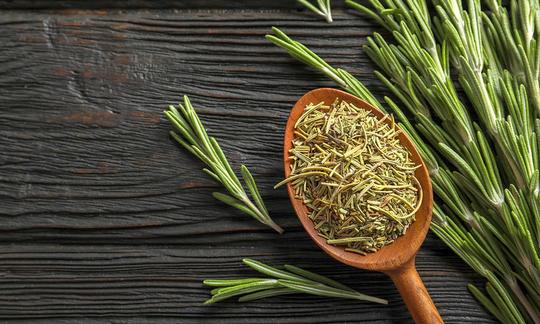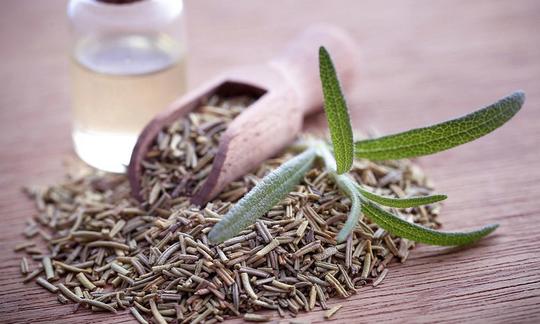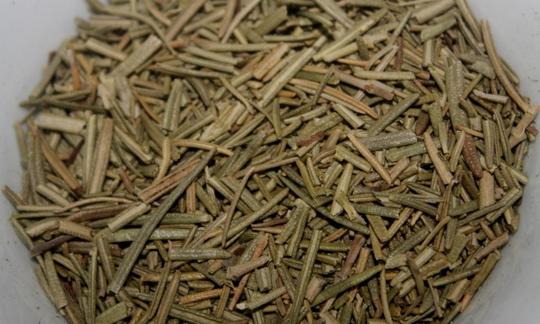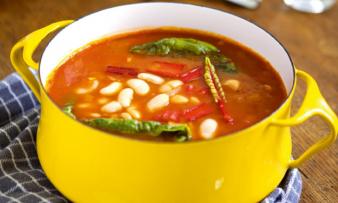Table of contents
How do I use dried rosemary ? Dried sea dew or rosemary ( Rosmarinus officinalis or Salvia rosmarinus) is suitable for seasoning a wide variety of dishes. If the needles are undamaged, it hardly loses any of its aroma.
Use in the kitchen:
Dried rosemary has an intense, aromatic and slightly bitter taste with subtle resin nuances. The Mediterranean herb should be used carefully so as not to mask the natural taste of the food. Rosemary develops its full aroma when exposed to heat.
What do you season with rosemary? Dried rosemary is used in the kitchen in at least as many different ways as fresh rosemary. In Mediterranean cuisine, rosemary is found in vegetable, pasta and potato dishes. Rosemary also tastes good in salads, soups, stews, hearty dishes and raw vegetables. Rosemary tastes particularly good with mushrooms, but also with desserts, apple jellies or honey.
What goes well with rosemary? Herbs that harmonize with the spicy, resinous tasting rosemary are other Mediterranean herbs such as thyme, oregano or savory as well as allium herbs and spices such as garlic, onions or wild garlic. In its dried form, rosemary is an essential component of the Provence herb mixture or of many barbecue spice mixtures.
What else can you use dried rosemary for? In addition to being used as a spice, rosemary is also delicious as a tea and is a common ingredient in invigorating and calming tea blends. 1 Freshly ground rosemary can be used to flavor salt. However, the aroma quickly evaporates when the rosemary needles are processed and chopped.
Vegan recipe for bean stew with rosemary:
Ingredients : 400 g white beans, dried and soaked; 1 raw onion, peeled and chopped; 2 garlic cloves, peeled and chopped; 4 tbsp olive oil ; 1 tsp ground cumin ; 1 tsp pimentón de la Vera (smoked paprika powder); 1 tsp dried rosemary; 2 bay leaves ; ¼ tsp cayenne pepper ; 400 g chopped canned tomatoes ; 80 g chard in bite-sized pieces; 500 ml low-salt vegetable stock and 1 pinch of salt.
Preparation : Sauté half of the onion and garlic with half of the olive oil. Add the soaked beans, cover with water and simmer for 25 minutes. In a second pan, heat the remaining olive oil and sauté the other half of the onion and garlic. Add the tomatoes and spices. Simmer the sauce for 5 minutes. Now add the chard pieces, the cooked beans and the vegetable stock to the tomatoes and simmer everything together for another 20 minutes, or until the beans are cooked.
Finally, you can season the stew with salt and add more seasoning if necessary. The "Estofado de alubias con acelgas" is best served warm.
Recipe for rosemary tea:
Preparation : Pour 1-2 teaspoons of dried rosemary leaves into 250 ml of boiling drinking water and let the herbal infusion steep for 10-15 minutes (you can also use fresh rosemary needles). Drink this three times a day. 2,3
A tried and tested tea blend for a relaxing, calming tea contains 30 g of lemon balm leaves, 20 g of angelica root, 20 g of hop cones, 10 g of rosemary leaves, 10 g of lavender flowers and 10 g of chamomile flowers. 3
For rosemary baths, you can also boil 50 g of the medicinal herb with a liter of water and then leave it covered for 15-30 minutes. The aqueous extract solution is poured through a sieve and added to the bath. 1
For more recipes using dried rosemary, see the link: " Recipes that make the most of this ingredient ".
| Not only vegans or vegetarians should read this: Vegans often eat unhealthily. Avoidable nutritional errors. |
Shopping - where to buy?
In Europe and America, dried rosemary in controlled organic and conventional quality can be found in the spice section of many grocery stores. Rosemary can be bought in supermarkets such as Coop, Migros, Denner, Volg, Spar, Aldi, Lidl, Rewe, Edeka, Hofer etc. or in organic supermarkets such as Denns or Alnatura. Rosemary is also available in health food stores, organic shops, drugstores or online shops.
The season for fresh rosemary in the northern hemisphere is from April to September. Fresh rosemary branches are easy to dry yourself, for example by hanging them up.
Rosemary leaves are a component of tea blends for cardiovascular or nervous disorders. Calming teas contain 5 g of rosemary per 100 g of tea according to standard approval. 1
Wild - Season:
Rosemary can be found in the Mediterranean region on dry and sunny slopes, on limestone, in sparse bushes and on the edges of forests. There, the typical Mediterranean plant blooms as early as January, further north from March to July. North of the Alps, rosemary is mainly found in gardens. Season: The foliage and flower tips are preferably harvested in spring and early summer. Rosemary needles can be harvested all year round for personal use. 2,4,5,6
The medicinal drug comes largely from wild collection. 1,4
Homemade preparation:
Can you dry rosemary? Rosemary is very easy to dry at home. It is important to dry it gently, as the essential oils are very volatile.
When harvesting, make sure that there has been no rainfall for the last two or three days. The ideal time to harvest is midday. Do not wash the branches before drying, as this increases the risk of mold.
To dry, hang freshly cut, loosely tied rosemary branches in a place with good air permeability and low humidity. Alternatively, strip the needles from the branches, lay them out on a kitchen towel and turn them several times a day. 7 The plant parts should be protected from direct sunlight while drying. Rooms such as boiler rooms, dark, warm basements or the attic are suitable. 7
If you hear a distinct crackling sound when the needles break after 2-3 weeks, they are dry. For further use, you can roughly chop or finely grind the needles using a mortar or a food processor (spice mill or coffee grinder). 7
For a faster drying process, you can dry rosemary needles in the oven with circulating air or in a dehydrator. In this case, you can wash the rosemary before drying and then pat it dry. The oven door should be left ajar using a wooden spoon so that the moisture can escape. Turn the rosemary needles every hour. Ideally, the drying temperature should be between 30 and 40 °C and the drying time should be around 2-3 hours.
Storage:
How long does rosemary last? Rosemary leaves can be kept for several years without significant loss of flavor. Ground rosemary quickly loses its flavor. 4
Dried rosemary should be stored in tightly sealed glass, porcelain or metal containers, protected from moisture, heat and light. Plastic containers are unsuitable as they have a negative effect on the essential oil. 1
Ingredients - nutritional value - calories:
The exact composition of rosemary varies depending on the origin of the plant. The active ingredients of rosemary are 1-1.25% essential oils (including borneol, camphor, cineol), tannins, bitter substances, resins, flavonoids, plant acids and saponin. 2,3
Dried herbs generally contain a wide variety of important minerals and vitamins in concentrated form.
Dried rosemary is rich in iron and calcium. Notable vitamins are folate (folic acid) and pyridoxine (vitamin B6). 8.9 100 g of dried rosemary cover more than 100% of the daily requirement of these nutrients. Since spices are generally used sparingly, one should ensure that one's diet is varied and natural.
Good plant-based sources of iron are wild mallow (78 mg/100g) or sesame (14.55 mg/100g). Calcium can also be obtained in abundance from sesame (975 mg/100g) and other dried herbs. Foods rich in folate are raw beans, lupine seeds (355 µg/100g), raw wheat germ (281 µg/100g) or peanuts (240 µg/100g). Plenty of pyridoxine (vitamin B6) can be obtained from rice bran (4,070 mg/100g) or pistachios (1,700 mg/100g). 8.9
Almost all herbs and spices have a particularly favorable ratio between the anti-inflammatory omega-3 fatty acid (ALA, α-linolenic acid) and the pro-inflammatory omega-6 fatty acid (LA, linoleic acid). The LA:ALA ratio in fresh rosemary (sea dew, marigold) and dried rosemary is also at the ideal value of 1:1.
The complete ingredients of dried rosemary, the coverage of the daily requirement and comparison values with other ingredients can be found in our nutrient tables. In the article Nutrients explained you will get a detailed insight into the topic. CLICK FOR below the ingredients picture.
Health aspects - effects:
What are the effects of rosemary? There are numerous publications on the pharmacological effects of rosemary and some of its active ingredients. The effects are usually based on individual animal experiments ( in vitro or in vivo), rarely on humans. 4
Rosemary has antibacterial, antiviral, antioxidant, antispasmodic, anti-inflammatory, analgesic and positive effects on the heart's ability to contract. 1,10
Dangers - Intolerances - Side effects:
The daily dose for internal use is 4-6 g of rosemary leaves. 10 When taking large amounts of rosemary oil, side effects such as stomach, intestinal and kidney irritation can sometimes occur. 4 Pregnant women should refrain from taking preparations made from rosemary leaves internally, as components of the essential oil can cause toxic side effects. 1
Use as a medicinal plant:
The parts of the plant used medicinally are the leaves (Rosmarini folium or folia) and the rosemary oil obtained from them (Rosmarini aetheroleum). Recognized areas of application include digestive problems, mild cramp-like gastrointestinal complaints and impairment of liver and gall bladder function. 1
Folk medicine - naturopathy:
Current indications in traditional medicine are given during recovery, but also in cases of coronary heart disease, chronic liver disease and to increase appetite and gastric juice secretion. 10
Other uses in modern folk medicine include digestive support, headaches, migraines, bronchitis, colic, respiratory infections, urinary tract diseases and painful menstruation. Rosemary is used externally to treat hair loss. 4
Occurrence - Origin:
Rosemary is found in southern Europe, especially in the coastal regions of the western and central Mediterranean: Portugal, Spain, southern France, Italy, Greece, Turkey, Morocco, Tunisia and the Caucasus region. 4 The plant is common on dry, sunny and calcareous slopes. 2
Growing in the garden or as a potted plant:
The heat-loving rosemary is best planted or placed in a sunny, wind-protected location. Dry, loose substrate with lots of nutrients is ideal for maintaining a healthy plant. Rosemary (as a spice or ornamental plant) tolerates calcareous soil, but not waterlogging. Potted plants can be overwintered in a bright place indoors at temperatures between 5 and 10 °C. Outdoors, the plant must be well covered on the ground with straw, leaves or brushwood. If the location is very windy, garden fleece is suitable for the above-ground parts. 15 Rosemary is very easy to propagate from cuttings.
From a healthy plant you can harvest tasty rosemary sprigs all year round.
Animal protection - species protection - animal welfare:
Rosemary serves as food for bees mainly during the months of May to September (summer forage). Forage is the general term for the food that the bees bring in, i.e. nectar, pollen and honeydew. The nectar value of rosemary is high and the pollen value is low (nectar value and pollen value scale: none, low, medium, high, very high). The two values reflect the value for insects and serve as guidelines and decision-making aids for bee and insect-friendly new plantings and gardening. 6
Hymenoptera and occasionally moths are among the intensive visitors to rosemary flowers. 6 Bees often visit the flowers because they offer a lot of food in the form of nectar. 2
Danger of confusion:
The leaves of common rosemary ( Rosmarinus officinalis) can be confused with those of the highly poisonous rosemary heath (or rosemary heath: Andromeda polifolia). The important distinguishing features are the leaves of the rosemary heath, which can be up to 3 cm long (so slightly longer than those of rosemary), their spherical corolla (rosemary flowers are two-lipped and bell-shaped) and their fruit, which is a capsule (rosemary has a herb with four seeds). 11
In the Northern Hemisphere, heather is widespread in heathland and moorland landscapes in Eurasia and North America.
General information:
According to Wikipedia , Rosmarinus officinalis was classified as a genus in the genus Rosmarinus in the mint family (Lamiaceae). 12 Rosmarinus officinalis included the three subspecies Rosmarinus officinalis subsp. officinalis, Rosmarinus officinalis subsp. palaui and Rosmarinus officinalis subsp. valentinus. According to recent research, these subspecies or varieties are now grouped together under the name Salvia rosmarinus Spenn. in the genus Salvia ; Salvia rosmarinus has replaced Rosmarinus officinalis as a synonym. 13,14
Alternative names:
Alternative names for rosemary are Anthoskraut, hochzeitskleid, Hochzeitsbleaml, Kid, Meertau, Röselimarie, Weihrauchkraut, Krankrautblätter, Kranzenkraut or Kranzenkrautblätter. We also found the spellings Rozmarin and Rosmarien.
In English, rosemary is called rosemary or anthos. In Spanish, the plant is called romero.
Literature - Sources:
Bibliography - 13 Sources (Link to the evidence)
| 1. | Blaschek W. (Herausgeber). Wichtl – Teedrogen und Phytopharmaka. Ein Handbuch für die Praxis. 6. Auflage. Stuttgart; 2016. Wissenschaftliche Verlagsgesellschaft mbH. |
| 2. | Pahlow M. Das grosse Buch der Heilpflanzen. Gesund durch die Heilkräfte der Natur. 8. Auflage. Hamburg; 2013. Nikol Verlagsgesellschaft mbH & Co. KG. |
| 3. | Niederegger O, Mayr C. Heilpflanzen der Alpen. Gesundheit aus der Natur von A bis Z. Innsbruck; 2006. Tyrolia-Verlag. |
| 4. | wissenschaftliche-verlagsgesellschaft.de Rosmarin. Rosmarinus officinalis. |
| 5. | Bown D. Kräuter. Die grosse Enzyklopädie. Anbau und Verwendung. 2. Auflage. München; 2015. Dorling Kindersly. |
| 6. | Kremer BP. Mein Garten – Ein Bienenparadies. 2. Auflage. Bern; 2018. Haupt Verlag. |
| 7. | gartenjournal.net Rosmarin trocknen. |
| 10. | Schilcher H, Kammerer S, Wegener T. Leitfaden Phytotherapie. 3. Auflage. München; 2007. Elsevier GmbH. |
| 11. | Fleischhauer SG, Guthmann J, Spiegelberger R. Enzyklopädie. Essbare Wildpflanzen. 2000 Pflanzen Mitteleuropas. 1. Auflage. Aarau; 2013. AT Verlag. |
| 12. | Wikipedia Rosmarin. |
| 13. | Drew BT, González-Gallegos JG et al. Salvia united: The greatest good for the greatest number. Taxon. 66(1). 2017: S. 133–145. DOI:10.12705/661.7 |
| 14. | Hong Wu, Peng-Fei Ma et al. Comparative plastomic analysis and insights into the phylogeny of Salvia (Lamiaceae). Plant Diversity 2020. "In Press" am 30.11.2020. DOI: 10.1016/j.pld.2020.07.004. |
| 15. | hausgarten.net Rosmarin pflegen. |













Comments